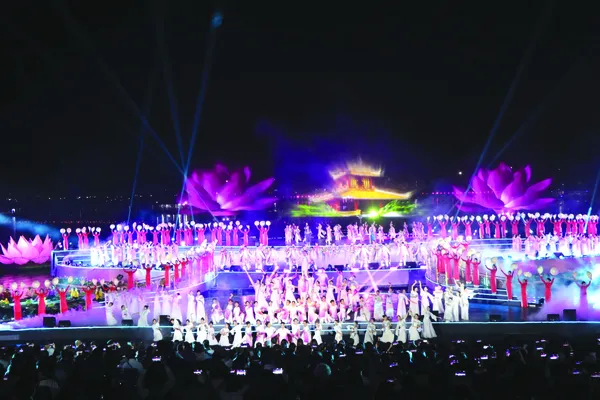 Features
Features

To Mông ethnic women in mountainous areas of Việt Nam, their traditional outfits reveal more than just their self-image. Hồng Vân & Lê Hương report.
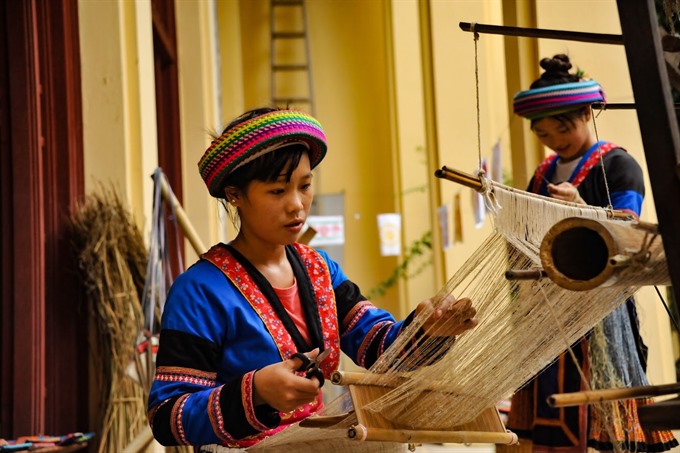 |
| Meticulous: The process of making clothes is long and painstaking, sometimes taking up to two years for a single garment. VNS Photo Hiếu Nguyễn |
To Mông ethnic women in mountainous areas of Việt Nam, their traditional outfits reveal more than just their self-image. Hồng Vân & Lê Hương report
Clothes can reflect a lot about the wearer’s personality and self-image.
To Mông ethnic women in mountainous areas of Việt Nam, their traditional outfits reveal more than just their self-image. The garments, made by hand, are considered a way to evaluate a woman’s skill in weaving.
“Most Mông women know how to make traditional dresses by themselves. Her outfit tells you whether she is skilled or not,” said Sùng Thị Pà, a Mông literature teacher who works part-time at the Linen Cooperative in Quản Bạ District, Hà Giang Province.
Nowadays, due to the convenience of synthetic fibre fabric, many young Mông people prefer modern clothes to traditional ones made from organic materials.
“Traditional outfits are worn on special occasions, like festivals and weddings. Knowledge of how to make a traditional dress is still necessary for Mông women,” said Pà.
44460650PM.jpg) |
| On sale: Besides clothes, Mông people also produce hand made wallets, pillow cases and other items using traditional textiles and methods. VNS Photo Hồng Vân |
There are more than 1 million Mông people in Việt Nam, living mostly in poor and remote areas in northern mountainous provinces of Hà Giang, Tuyên Quang, Lào Cai, Yên Bái, Lai Châu, Sơn La and Cao Bằng, according to researcher Lưu Thị Hồng Ly.
The Mông mostly grow rice and maize as staple food; herbal medicines to treat themselves; lanh (flax) to weave clothes; and indigo to dye fabric.
Mông women spend most of their free time working on their dresses and blankets, which sometimes takes one or two years to finish. The image of charming Mông women weaving in their homes is a common sight when one visits Hà Giang.
While children in cities are busy with extra classes and activities, Mông girls are taught to weave linen at the age of 12.
Making the fabric requires lots of hard work and attention to detail. The whole process is done manually – planting flax, harvesting, drying, splitting and softening the flax threads by crushing them in stone mortars, boiling them in water mixed with ash and bee wax to make them softer and whiter, and weaving, drawing patterns and colouring.
“In recent years, most ethnic groups have switched to chemical dyes and very few still maintain the traditional practice of dying fabric with indigo. Among them are Mông people who have been using various types of leaves to colour fabric. They are very clever in mixing different types of leaves to create a diverse range of colours,” said researcher Ly.
Using indigo makes fabric softer and more durable while the aroma of indigo helps to prevent some skin diseases and keep insects like mosquitoes or leeches away, according to Ly.
Besides indigo, Mông women use various types of leaves to dye fabric including magenta (for purple), banana (for light pink), tea (for yellow brown), guava (for light yellow), pineapple mixed with wild betel and turmeric (for bright green).
The craft of weaving is mentioned in folk sayings as a ‘criterion’ to judge women’s character and skills: A Mông girl will struggle to find a husband if she doesn’t know how to weave brocade, as the local saying goes: "Beautiful women who have no skills of making flax linen are unattractive, and pretty girls who know nothing about sewing are not acceptable".
“When a woman gets married, her mother will give her two or three dresses, if her mother-in-law is also a Mông, she will be given one or two more as wedding gifts,” Sùng Thị Dính, a Mông woman, said.
The set of traditional clothes of a Mông woman includes a skirt, a shirt, an apron-like garment worn on the front and back of the body, a pair of stockings, a turban, a belt, and jewellery. The shirt has the most colourful embroidery, especially around the collar, while the skirt has an accordion pleat.
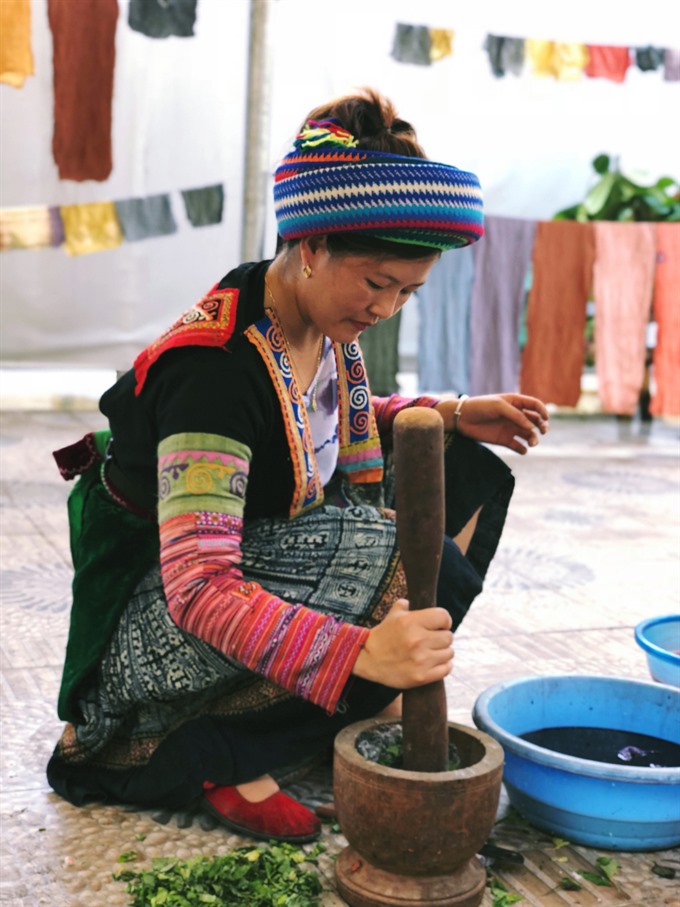 |
| Bright shades: Sùng Thị Dính grounds leaves to colour her fabric. VNS Photo Hồng Vân |
Organic clothes, a modern trend
Besides clothes, Mông women also produce a variety of items like bags, wallets, decorative fabric, tablecloths, curtains and pillow cases using the traditional textiles and patterns that have been passed down from generation to generation.
It is a way to keep their heritage alive, creates livelihoods for local people and also aligns with modern trends – the use of organic materials in fashion.
According to scientists, there are 12,000 species of plants in Việt Nam, 200 of which can be used as dyes. There are 48 types used by ethnic people to colour their clothes and food.
Dương Thị Thanh Nga, a researcher from the Việt Nam Ethnic Culture Museum, said: “Using natural materials in the production of clothing is now a sustainable development trend, these valuable resources are being awakened after being forgotten for a long time.”
Designer Vũ Thảo said: “The fashion scene in Việt Nam has developed rapidly over the past 10 years and there are many different directions for Vietnamese designers to follow. Fashion is becoming more mainstream and mass-produced, so we end up wearing quite similar styles. It becomes such a global platform to express ourselves. For me, being a part of it and witnessing the change of fashion internationally and locally is fascinating and also, it’s challenging to find my own direction.”
When Thảo was more heavily involved in designing, she saw the downsides of it.
“The waste in the fashion industry is high and the effect it has on our environment is getting worse. Meanwhile, mass produced products are making the fashion scene very flat. There’s not much diversity and we are facing the challenge of losing it,” said Thảo.
The fashion industry also poses some concerning social issues, she said.
“The fashion industry is so profitable. To be able to make more profit, many fashion houses cut corner.
“It’s where the fees for manufacturers are cut and their working conditions are bad. Big fashion houses go through many middle men before it is handed to the workers who do the most of the work but barely make a living out of it.
“The fashion industry also lacks connections with the origin of goods. There’re always labels, tags saying about where it’s made but it means nothing. You never know who exactly made it and how it’s made, where it’s really made… It’s a broken supply chain,” said Thảo.
“That makes me very upset. I don’t want to walk on that road. It’s not my way of working and doesn’t suit my design philosophy. At the same time, Việt Nam, among very few countries with rich and diverse culture, is losing many traditions.
“The rest of the world is hunting for sustainable materials and unique crafts. We need to grasp this opportunity,” Thảo said.
Thảo founded her own brand, Kilomet109, in 2012, with the vision of "encompassing every detail of the production process, starting with the natural materials that go into the garments she designs".
She uses organic fibres and traditional techniques of vegetable dying. She works with her team of local artisans to grow, spin, weave, colour and print Kilomet109 fabrics. After that, the garments are hand-stitched in her studio in Hà Nội.
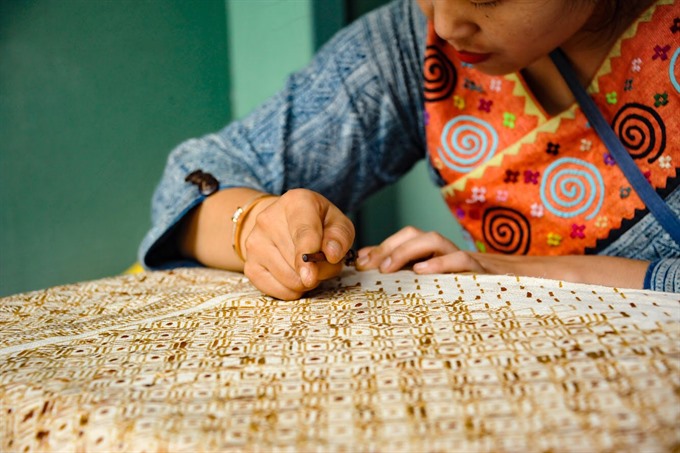 |
| Detailed: Sùng Thị Pà applies bees wax to cloth to create unique patterns. VNS Photo Hiếu Nguyễn |
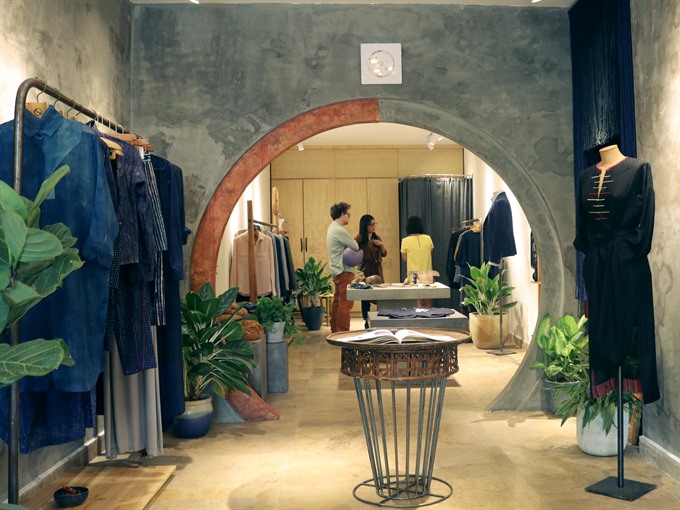 |
| Sustainable: Vũ Thảo (centre) is among few designers in Việt Nam who has built an eco-fashion brand. VNS Photo Hồng Vân |
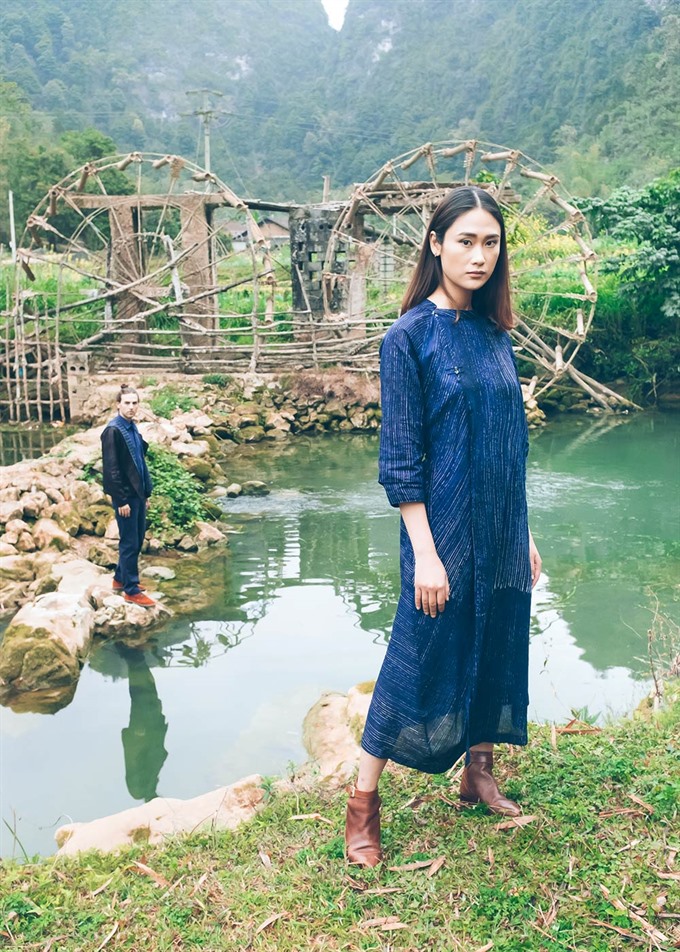 |
| Natural clothing: Thảo uses organic fibers and traditional techniques of vegetable dying. She works with her team of local artisans to grow, spin, weave, colour and print fabrics. Photo courtesy of kilomet109 |
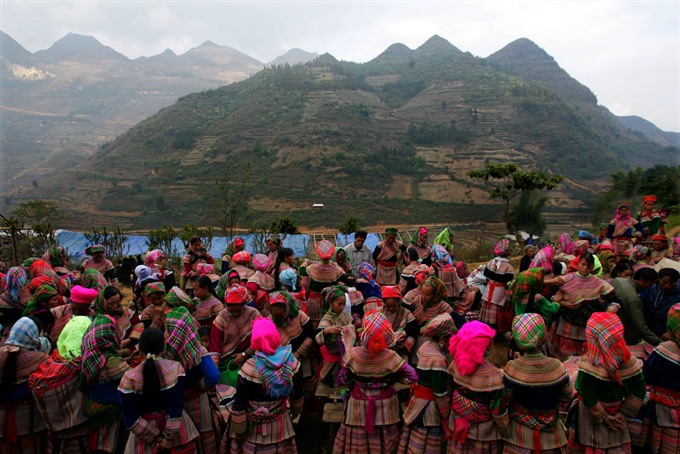 |
| Colourful: Mông people at a traditional market in northern province of Hà Giang. VNS Photo Việt Thanh |
About 30 per cent of her customers are Vietnamese and the rest are international.
“I think eco-fashion is becoming a common term. The media is talking about it. Students in fashion and design schools mention it quite regularly. So it’s not a term that you talk about theoretically, it’s something practical in Việt Nam," said Thảo.
“A number of Vietnamese designers, especially the young, are now aware about what is happening around us. They focus on not only fashion but also culture as well as current issues of Việt Nam and the world. That really helps young designers find their own voice and be different with the rest of the world. It also opens another door for designers to follow the sustainable movement.
“There are many people who can help designers, including artisans, local creators, makers, researchers, influencers, journalists, students working in different fields.
“I think the young generation is more responsible for their own environment. They have more access to the internet and social media, they are engaged so that’s why they know more and are aware about more, they take responsibility for it as well."
“I’m very positive about the future of eco-fashion in Việt Nam and totally believe in it. The more developed we are, the more sustainable we become. That’s the healthy way of developing. That makes Việt Nam more competitive in the global market. Because the normal business term is not going to be the future form, the future business has to take responsibility for the environment, for social issues, and we have to care about our own culture and roots. So it should be the movements that the government and people need to join,” Thảo added. VNS




